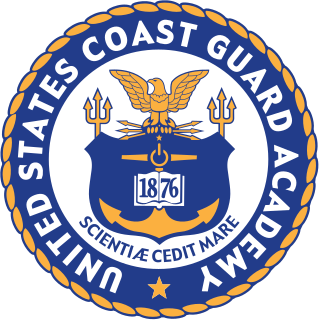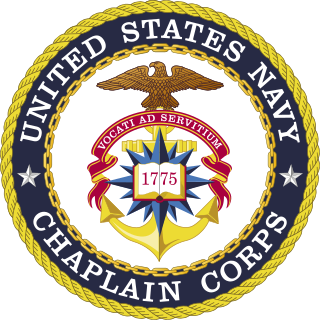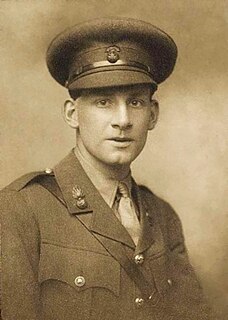Commodore is a naval rank used in many navies that is superior to a navy captain, but below a rear admiral. Non-English-speaking nations often use the rank of flotilla admiral, counter admiral, or senior captain as an equivalent, although counter admiral may also correspond to rear admiral.

In military organizations, a colour guard is a detachment of soldiers assigned to the protection of regimental colours. This duty is so prestigious that the colour is generally carried by a young officer (Ensign), while experienced non-commissioned officers are assigned to the protection of the flag. These NCOs, accompanied sometimes by warrant officers, can be ceremonially armed with either sabres or rifles to protect the colour. Colour guards are generally dismounted, but there are also mounted colour guard formations as well.
Rear admiral is a naval commissioned officer rank above that of a commodore and captain, and below that of a vice admiral. It is generally regarded as the lowest of the "admiral" ranks, which are also sometimes referred to as "flag officers" or "flag ranks". In many navies it is referred to as a two-star rank (OF-7)/(O-7).

The United States Coast Guard Academy (USCGA) is the service academy of the United States Coast Guard, founded in 1876 and located in New London, Connecticut. It is the smallest of the five federal service academies and provides education to future Coast Guard officers in one of nine major fields of study. Unlike the other service academies, the Coast Guard Academy does not require a congressional nomination for admission.

The United States Merchant Marine Academy, one of the five United States service academies, is located in Kings Point, New York. It is charged with training officers for the United States Merchant Marine, branches of the military, and the transportation industry. Midshipmen are trained in marine engineering, navigation, ship's administration, maritime law, personnel management, international law, customs, and many other subjects important to the task of running a large ship.
A tactical formation is the arrangement or deployment of moving military forces such as infantry, cavalry, AFVs, military aircraft, or naval vessels. Formations were found in tribal societies such as the "pua rere" of the Māori, and ancient or medieval formations which include shield walls, phalanxes, Testudo formation and skirmishers.
Tactical formations include:
In military parlance, the rear is the part of concentration of military forces that is farthest from the enemy. The rear typically contains all elements of the force necessary to support combat forces - food, medical supplies and substantial shelters, planners and command headquarters.
Commodore was an early title and later a rank in the United States Navy, United States Coast Guard and the Confederate States Navy. For over two centuries, the designation has been given varying levels of authority and formality.

The Mauser HSc is a 7.65mm pistol made in Nazi Germany during World War II and post-war. The designation HSc stood for Hahn Selbstspanner Pistole, third and final design "C". Production was continued in 1945–46 during the French occupation and, later, from 1968 to 1977 by Mauser. It features a semi-exposed hammer, double-action trigger, single-column magazine, and a spring surrounding the barrel.
This article covers the organization of the United States Coast Guard.

Military organization or military organisation is the structuring of the armed forces of a state so as to offer such military capability as a national defense policy may require. In some countries paramilitary forces are included in a nation's armed forces, though not considered military. Armed forces that are not a part of military or paramilitary organizations, such as insurgent forces, often mimic military organizations, or use ad hoc structures, while formal military organization tends to use hierarchical forms.
Rear admiral in the United States refers to two different ranks of commissioned officers — one-star flag officers and two-star flag officers. By contrast, in most nations, the term "rear admiral" refers to an officer of two-star rank.
The Wyoming Army National Guard is the Army National Guard of Wyoming. It includes army aviation, construction engineers, field artillery and medical asset units. It was reorganized in 1996, consolidating its two field artillery battalions into a single battalion. A ribbon bridge company and rear operations center for an infantry division were added to the Guard.

Mary E. Landry is an American disaster-management official and retired rear admiral of the United States Coast Guard.

The Chief of Chaplains of the United States Navy (CHC) is the Senior Chaplain in the Navy, the Head of the U.S. Navy Chaplain Corps, and the Director of Religious Ministry Support for the Department of the Navy. He or she advises the Commandant of the Marine Corps, the Chief of Naval Operations, and the Commandant of the Coast Guard "on all matters pertaining to religion within the Navy, United States Marine Corps, and United States Coast Guard."

The Chaplain of the United States Marine Corps (CHMC) is a position always filled by the officer serving as Deputy Chief of Chaplains of the United States Navy as a "dual hatted" billet since 2000. The CHMC oversees religious ministry in the Marine Corps which one Commandant of the Marine Corps defined as "a vital function which enhances the personal, family, and community readiness of our Marines, sailors, and their families. Chaplaincy supports the foundational principle of free exercise of religion and helps to enrich the spiritual, moral and ethical fabric of the military."
The 57th Cavalry Division was a cavalry formation of the Red Army during the World War II.
The Military ranks of Turkey are the military insignia used by the Turkish Armed Forces.








